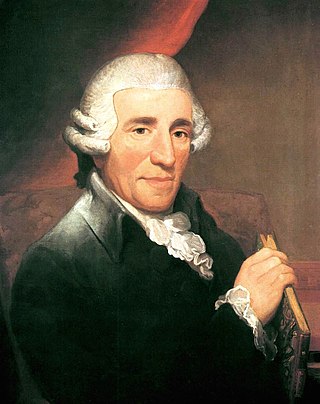
Symphony No. 44 in E minor, Hoboken I/44, was completed in 1772 by Joseph Haydn. It is popularly known as Trauer. An apocryphal story relates that Haydn asked for the slow movement of this symphony to be played at his funeral.
Symphony No. 103 in E♭ major is the eleventh of the twelve London symphonies written by Joseph Haydn. This symphony is nicknamed The Drumroll after the long roll on the timpani with which it begins. It is from 1795, and his second-to-last symphony.

The Symphony No. 70 in D major, Hoboken 1/70, was written by Joseph Haydn to mark the start of construction of a new opera house on the Eszterháza estate. It was premiered on December 18, 1779—one of the few Haydn symphonies where the exact premiere date is known.
Joseph Haydn's Symphony No. 46 in B major, Hoboken I/46, was composed in 1772, during his Sturm und Drang period.

Symphony No. 67 in F major, Hoboken I/67, is a symphony by Joseph Haydn. It was composed by 1779. The Haydn scholar H. C. Robbins Landon calls this work "one of the most boldly original symphonies of this period."
Joseph Haydn's Symphony No. 47 in G major Hob. I:47 was probably written in 1772. It was nicknamed "The Palindrome".
The Symphony No. 38 in C major, Hoboken I/38, is an early and festive symphony by Joseph Haydn. The symphony was composed some time between 1765 and 1769. Because of the virtuosic oboe parts in the final two movements, it has been suggested that the work's composition may have coincided with the employ of the oboist Vittorino Colombazzo in the fall of 1768. The symphony is popularly called the Echo Symphony, a nickname that, like all other named Haydn symphonies, did not originate with the composer.

The Symphony No. 30 in C major, Hoboken I/30, is a symphony by Joseph Haydn composed in 1765, at the age of 33. It is nicknamed the Alleluia Symphony because of Haydn's use of a Gregorian Alleluia chant in the opening movement.

Symphony No. 35 in B♭ major, Hoboken I/35, was written by Joseph Haydn. The autograph score is "carefully" dated "December 10, 1767". It has been speculated that this symphony was written to celebrate Prince Esterházy's return from a visit to the Palace of Versailles.

The Symphony No. 32 in C major is a festive symphony by Joseph Haydn. The exact date of composition is unknown. It has been suggested by noted Haydn scholar H.C. Robbins Landon that it could have been written as early as 1757 and as late as 1763. More recent scholars have suggested it was composed in either 1760 or 1761

The Symphony No. 33 in C major is a festive symphony by Joseph Haydn. The precise date of composition is unknown. Haydn scholar H.C. Robbins Landon has dated this work to 1763–65. It has also been suggested that it was written in 1760 or 1761, along with Symphony no. 32.

The Symphony No. 25 in C major, Hoboken I/25, is a symphony by Joseph Haydn.The symphony was most likely composed in 1763, or at the very earliest in 1761, at about the same time as No. 33.

Joseph Haydn's Symphony No. 29 in E major, Hoboken I/29, was written in 1765, just after his 28th, and to be performed in Eisenstadt, under the benign auspices of Prince Nikolaus Esterházy.
Joseph Haydn's Symphony No. 3 in G major, Hoboken I/3, is believed to have been written between 1760 and 1762.
Joseph Haydn's Symphony No. 4 in D major, Hoboken I/4, is believed to have been written between 1757 and 1761.

Joseph Haydn's Symphony No. 14 in A major, Hoboken I/14, may have been written between 1761 and 1763.

Joseph Haydn's Symphony No. 15 in D major, Hoboken I/15, may have been written between 1760 and 1763.
The Symphony No. 9 in C major, Hoboken I/9, is a symphony by Joseph Haydn. The symphony was composed in 1762, under the auspices of Nikolaus Esterházy, who allowed the symphony to be performed in Eisenstadt.

Joseph Haydn's Symphony No. 11 in E♭ major is a symphony which may have been written as early as 1760 but no later than 1762, meaning that it was written for either the orchestra of the salubrious Count Morzin or the noble Paul II Anton, Prince Esterházy's palace in Eisenstadt.

The Symphony No. 18 in G major, Hoboken I/18, is a symphony by Joseph Haydn. The composition date is conspicuously uncertain. The Breitkopf catalogue entry assures that it was composed no later than March 1766, the date of the Esterhazy orchestra moving to Esterhaza, but most scholars believe it was composed at least a few years before then. Dates between 1757 and 1764 have been also suggested but not proven.

